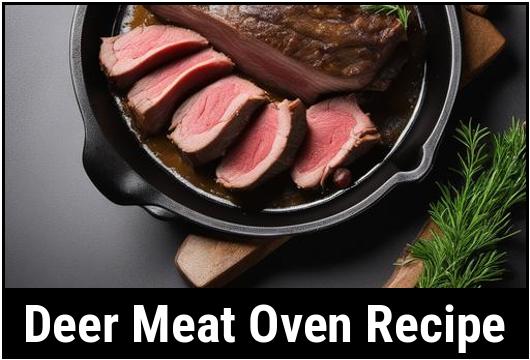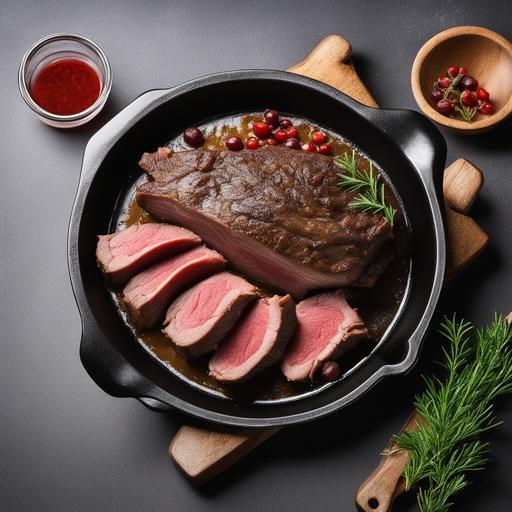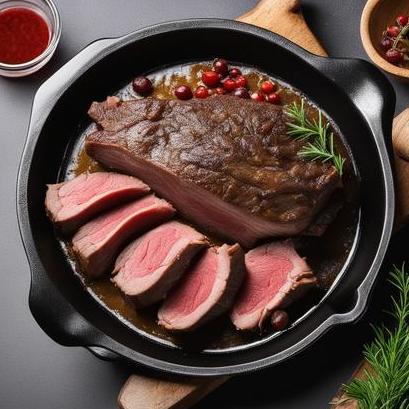
Deer Meat Oven Recipe: Savory Delights For All Food Enthusiasts
Deer meat, also known as venison, is a lean and flavorful meat that has been enjoyed for centuries by food enthusiasts around the world. Renowned for its unique taste and tender texture, venison offers a delightful twist to any culinary creation. In this comprehensive article, we will explore the art of cooking deer meat in the oven, uncovering the food science, culinary details, selection, cleaning, preparation, tips, variations, doneness checks, and even address potential concerns of overcooking or undercooking this exquisite meat.
Unveiling the Science behind Deer Meat: A Hint of Flavors
1. Rich Protein Content
Deer meat is an excellent source of lean protein, making it a healthy alternative to other types of red meat. Boasting an abundance of essential amino acids, venison aids in muscle growth, repair, and overall maintenance of our body’s internal functions.
2. Low-Fat Content
With a significantly lower fat content compared to traditionally used red meats like beef, deer meat promises a healthier option for those seeking to maintain a well-balanced diet. The absence of excessive fat contributes to its naturally tender quality and unique flavor profile.
3. Essential Nutrients
Venison is an excellent source of essential nutrients, including iron, zinc, and B vitamins. These nutrients act as catalysts for numerous bodily functions, including boosting the immune system, enhancing red blood cell production, and promoting overall vitality.
Selecting and Cleaning Your Deer Meat: Ensure Optimal Flavor
1. Selection Tips
When choosing venison, opt for cuts that have a deep reddish color with minimal discoloration. Fresher cuts tend to be more tender and have a milder gamey flavor. Avoid purchasing meat that appears dry or has an off-putting smell. It’s important to select meat that is from a reputable source to ensure quality and safety.
2. Cleaning and Butchering
Before embarking on your culinary journey, it is crucial to properly clean and butcher the deer meat. Ensure your work area is clean, and use a sharp set of knives to trim away any excess fat, silver skin, and connective tissue. This meticulous preparation will optimize the tenderness and flavor of the final dish.
Preparing your Venison for a Culinary Masterpiece

1. Marinating for Enhanced Flavor
Marinating deer meat is an exceptional way to infuse additional flavors and tenderize the meat. Choose marinades based on personal preferences, considering ingredients like red wine, herbs, garlic, and vinegar to complement the natural flavors of the venison. Allow the meat to marinate, refrigerated, for at least 2 to 4 hours or overnight for maximum flavor penetration.
2. Seasoning and Rubs
Applying a dry rub or seasoning mix to the deer meat before cooking can further elevate the flavors. Consider blending ingredients such as garlic powder, paprika, freshly ground pepper, and herbs to create a tantalizing crust that perfectly complements the venison’s natural richness.
3. Achieving Optimal Taste: Cooking Temperatures and Times
To ensure your deer meat reaches the perfect doneness, follow these cooking temperature guidelines:
- Medium-Rare (Preferred by Many): The internal temperature should reach approximately 135°F (57°C). The meat will be pinkish-red in the center and tender, preserving most of its natural juiciness and flavors.
- Medium: For a slightly more cooked result, aim for an internal temperature of 145°F (63°C). This will bring a touch more firmness to the texture while retaining moisture.
- Well-Done: If you prefer well-done meat, cook the deer meat to an internal temperature of 160°F (71°C). While this will slightly reduce tenderness, it can be an optimal choice for some recipes or personal preferences.
Delectable Deer Meat: Recipe Showcase
Prepare yourself for a culinary masterpiece with this exemplary oven-baked venison recipe. The succulent flavors and tender texture will leave your taste buds yearning for more.
Oven-Baked Herb-Crusted Deer Loin
Ingredients:
- 2 pounds (0.9 kg) deer loin
- 2 tablespoons olive oil
- 2 cloves garlic, minced
- 2 tablespoons fresh rosemary, finely chopped
- 2 tablespoons fresh thyme, finely chopped
- Salt and pepper to taste
Instructions:
- Preheat your oven to 375°F (190°C).
- In a small bowl, combine the minced garlic, rosemary, thyme, salt, and pepper, creating a fragrant herb blend. Set aside.
- Rub the deer loin with olive oil, ensuring it is evenly coated.
- Carefully apply the herb blend to all sides of the loin, gently pressing it in to adhere.
- Heat a cast-iron skillet or oven-safe pan over medium-high heat. Once hot, sear the deer loin on all sides for approximately 2 minutes per side. This step will help lock in the juices and develop a mouthwatering crust.
- Transfer the skillet or pan to the preheated oven and roast for 12-15 minutes for medium-rare, or adjust the cooking time according to your preferred doneness level.
- Remove the venison from the oven and let it rest for 5-10 minutes before slicing. This allows the juices to redistribute, resulting in a tender and succulent dish.
- Slice the oven-baked herb-crusted deer loin into thin medallions.
Tip: Pairing venison with a red berry reduction or savory mushroom sauce can elevate the flavors and add a touch of sophistication to your plate.
Exploring Delicious Variations

1. Exquisite Venison Steaks with Red Wine Reduction
- Grill or sear venison steaks to your desired doneness, following the cooking temperature guidelines provided earlier.
- Create a luxurious red wine reduction by simmering red wine, fresh herbs, and a touch of beef or vegetable broth until thick and glossy.
- Drizzle the red wine reduction over the venison steaks for a rich and elegant flavor combination.
2. Rustic Venison Stew
- Cut the venison into bite-sized pieces.
- Sauté onions, garlic, and celery in a large pot until softened.
- Add the venison, along with cubed carrots, potatoes, and a medley of your favorite herbs and spices.
- Pour in beef or vegetable broth, ensuring the ingredients are mostly submerged.
- Cover and simmer for several hours until the venison becomes tender and the flavors have melded together.
To Countercheck Doneness: Practical Tips
As with any meat, ensuring the venison is cooked to the desired level of doneness relies on a few key indicators:
- Temperature Check: Use a reliable meat thermometer to measure the internal temperature of the deer meat. Insert the thermometer into the thickest part of the meat, away from bones, for an accurate reading.
- Juices Test: For a quick visual check, slightly press down on the venison with a fork or tongs. The juices should appear a light pinkish hue for medium-rare, clear for well-done.
- Resting Period: Allowing the meat to rest after cooking is vital for optimal flavors and moisture retention. This resting period allows the juices to redistribute throughout the meat.
Avoiding Common Pitfalls: Overcooking and Undercooking
1. Overcooking Venison
Overcooked venison can result in a tough and dry texture, diminishing the unique qualities of the meat. Be mindful of the recommended cooking temperatures and times to preserve its inherent tenderness, flavor, and juiciness.
2. Undercooking Venison
Consuming undercooked venison may pose health risks due to the potential presence of parasites or bacteria. To ensure safety, always cook venison to the recommended internal temperatures mentioned earlier.
In Conclusion: A Culinary Adventure Awaits!
Venturing into the world of deer meat oven recipes opens up a world of gastronomic opportunities. From succulent roasts to tender medallions, venison unveils an array of possibilities for food enthusiasts seeking a unique and delightful culinary experience. Through proper selection, cleaning, preparation, and adherence to doneness checks, you can master the art of cooking this exquisite meat, promising an extraordinary gastronomic adventure to savor and share with friends and family.
Sources
FAQS On Deer Meat Oven Recipe
What Type Of Deer Meat Is Best For Oven Cooking?
Any type of deer meat can be cooked in the oven, but the most popular cuts are the hindquarters and the backstrap. Make sure to trim off any excess fat before cooking to prevent the meat from becoming too greasy.
What Temperature Should The Oven Be Set To When Cooking Deer Meat?
Preheat your oven to 300°F. This low and slow cooking method will allow the meat to cook evenly and tenderize without drying out.
What Are Some Good Seasoning Options For Deer Meat In The Oven?
While many people prefer to keep the seasoning simple with salt and pepper, other great options include garlic, rosemary, thyme, and smoked paprika. It all depends on personal taste preferences, so feel free to experiment with different seasonings to find your favorite.
How Long Does It Take To Cook Deer Meat In The Oven?
The cooking time will vary depending on the size and thickness of the meat. A general rule of thumb is to cook the meat for approximately 15-20 minutes per pound until it reaches an internal temperature of 145°F.
How Can I Tell If My Deer Meat Is Done Cooking In The Oven?
Use a meat thermometer to check the internal temperature of the meat. Once it reaches 145°F, remove it from the oven and allow it to rest for 10-15 minutes before slicing into it. The meat should be slightly pink in the center and fully cooked on the outside.


